Upgrading from an Intel Core i7-2600K: Testing Sandy Bridge in 2019
by Ian Cutress on May 10, 2019 10:30 AM EST- Posted in
- CPUs
- Intel
- Sandy Bridge
- Overclocking
- 7700K
- Coffee Lake
- i7-2600K
- 9700K

One of the most popular processors of the last decade has been the Intel Core i7-2600K. The design was revolutionary, as it offered a significant jump in single core performance, efficiency, and the top line processor was very overclockable. With the next few generations of processors from Intel being less exciting, or not giving users reasons to upgrade, and the phrase 'I'll stay with my 2600K' became ubiquitous on forums, and is even used today. For this review, we dusted off our box of old CPUs and put it in for a run through our 2019 benchmarks, both at stock and overclocked, to see if it is still a mainstream champion.
If you want to see all of our Core i7 benchmarks for each one of these CPUs, head over to anandtech.com/Bench
Why The 2600K Defined a Generation
Sit in a chair, lie back, and dream of 2010. It's a year when you looked at that old Core 2 Duo rig, or Athlon II system, and it was time for an upgrade. You had seen that Nehalem, and that the Core i7-920 was a handy overclocker and kicking some butt. It was a pleasant time, until Intel went and gave the industry a truly disruptive product whose nostalgia still rings with us today.
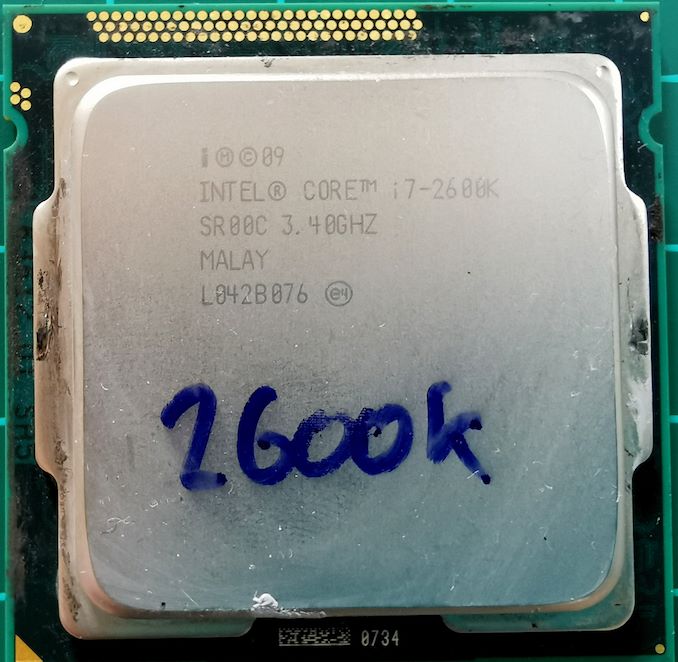

The Core i7-2600K: The Fastest Sandy Bridge CPU (until 2700K)
That product was Sandy Bridge. AnandTech scored the exclusive on the review, and the results were almost impossible to believe, for many reasons. In our results at the time, it was by far and above a leap ahead of anything else we had seen, especially given the thermal monstrosities that Pentium 4 had produced several years previous. Built on Intel’s 32nm process, the redesign of the core was a turning point in performance on x86, one which has not been felt since. It would be another 8 years for AMD to have its ‘Sandy Bridge’ (or perhaps more appropriately, a 'Conroe') moment with Ryzen. Intel managed to stand on the shoulders of its previous best product and score a Grand Slam.
In that core design, Intel shook things up considerably. One key proponent was the micro-op cache, which means that recently decoded instructions that are needed again are taken already decoded, rather than wasting power being decoded again. For Intel with Sandy Bridge, and more recently with AMD on Ryzen, the inclusion of the micro-op cache has done wonders for single threaded performance. Intel also launched into improving its simultaneous multi-threading, which Intel has branded HyperThreading for generations, slowly improving the core by making more of it dynamically allocated for threads, rather than static and potentially losing performance.
The quad-core design of the highest processor of the family on launch day, the Core i7-2600K, became a staple through Intel’s next five generations of the architecture, all the way through Ivy Bridge, Haswell, Broadwell, Skylake, and Kaby Lake. Since Sandy Bridge, while Intel has moved to smaller process nodes and taken advantage of lower power, Intel has been unable to recreate that singular jump in raw instruction throughput, with incremental 1-7% increases year on year, using that power budget to increase operational buffers, execution ports, and instruction support.
With Intel unable to recreate the uplift of Sandy Bridge, and with the core microarchitecture defining a key moment in x86 performance, users who purchased a Core i7-2600K (I had two) stayed on it for a long time. So much so in fact that a lot of people expecting another big jump became increasingly frustrated – why invest in a Kaby Lake Core i7-7700K quad-core processor at 4.7 GHz turbo when the Sandy Bridge Core i7-2600K quad core processor is still overclocked to 5.0 GHz?
(Intel’s answer was typically for power consumption, and new features like PCIe 3.0 GPUs and storage. But that didn’t sway some users.)
This is why the Core i7-2600K defined a generation. It had staying power, much to Intel’s initial delight then subsequent frustration when users wouldn’t upgrade. We are now in 2019, and appreciate that when Intel moved beyond four cores on the mainstream, if users could stomach the cost of DDR4, either upgraded to a new Intel system, or went down the AMD route. But how does the Core i7-2600K hold up to 2019 workloads and games; or perhaps even better, how does the overclocked Core i7-2600K fare?
Compare and Contrast: Sandy Bridge vs. Kaby Lake vs. Coffee Lake
Truth be told, the Core i7-2600K was not the highest grade Sandy Bridge mainstream desktop processor. Months after the 2600K launched, Intel pushed a slightly higher clocked 2700K into the market. It performed almost the same, and overclocked to a similar amount, but cost a bit more. By this time, users who had made the jump were on the 2600K, and it stuck with us.
The Core i7-2600K was a 32nm quad-core processor with HyperThreading, offering a 3.4 GHz base frequency and a 3.8 GHz turbo frequency, with a listed 95W TDP. Back then, Intel’s TDP was more representative: in our recent test for this article, we measured an 88W peak power consumption when not overclocked. The processor also came with Intel HD 3000 integrated graphics, and supported DDR3-1333 memory as standard. Intel launched the chip with a tray price of $317.
For this article, I used the second i7-2600K I purchased back when they were new. It was tested at both its out of the box frequency, and an overclocked frequency of 4.7 GHz on all cores. This is a middling conservative overclock – the best chips managed 5.0 GHz or 5.1 GHz in a daily system. In fact, I distinctly remember my first Core i7-2600K getting 5.1 GHz all-core and 5.3 GHz all-core during an overclocking event in the middle of the peak district one winter with a room temperature around 2C, where I was using a strong liquid cooler and 720mm of radiators. Unfortunately I crippled that chip over time, and now it won’t even boot at stock frequency and voltage. So we have to use my second chip, which wasn’t so great, but still a good representation of an overclocked processor. For these results, we also used overclocked memory, at DDR3-2400 C11.
It’s worth noting that since the launch of the Core i7-2600K, we have moved on from Windows 7 to Windows 10. The Core i7-2600K doesn’t even support AVX2 instructions, and wasn’t built for Windows 10, so it will be interesting to see where this plays out.
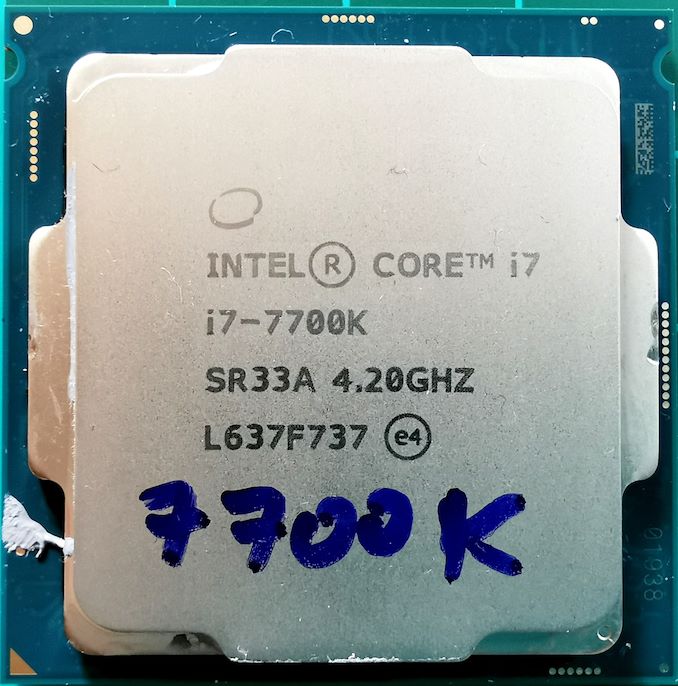
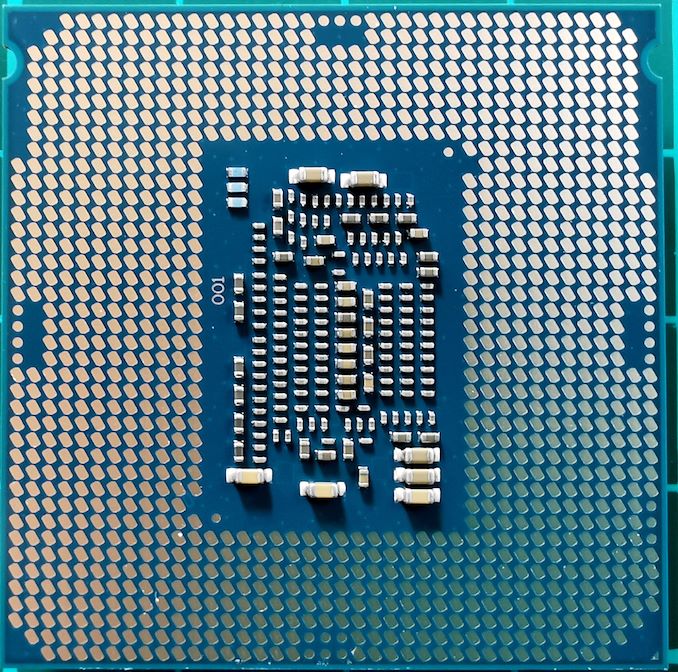
The Core i7-7700K: Intel's last Core i7 Quad Core with HyperThreading
The fastest and latest (final?) quad-core processor with HyperThreading that Intel released was the Core i7-7700K, which falls under the Kaby Lake family. This processor was built on Intel’s improved 14nm process, runs at a 4.2 GHz base frequency, and a 4.5 GHz turbo frequency. The 91W rated TDP, at stock, translated to 95W power consumption in our testing. It comes with Intel’s Gen9 HD 630 Graphics, and supports DDR4-2400 memory as standard. Intel launched the chip with a tray price of $339.
The Intel Core i7-7700K (91W) Review: The New Out-of-the-box Performance Champion
At the same time as the 7700K, Intel also launched its first overclockable dual core with hyperthreading, the Core i3-7350K. During that review, we overclocked the Core i3 and compared it directly to the out-of-the-box Core i7-2600K, trying to answer the question if Intel had managed to make a dual-core reach a similar performance to its old flagship processor. While the i3 had the upper hand in single threaded performance and memory performance, the two fewer cores ultimately made most tasks heavy work for the Core i3.
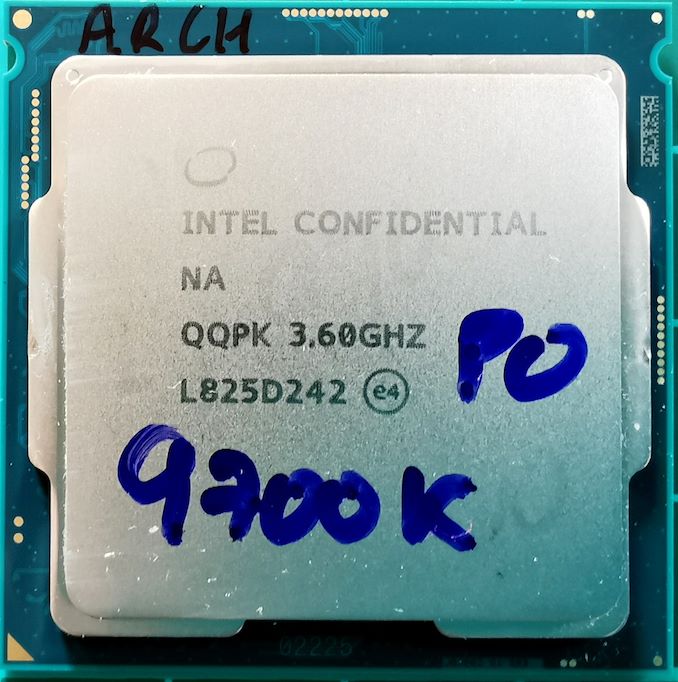
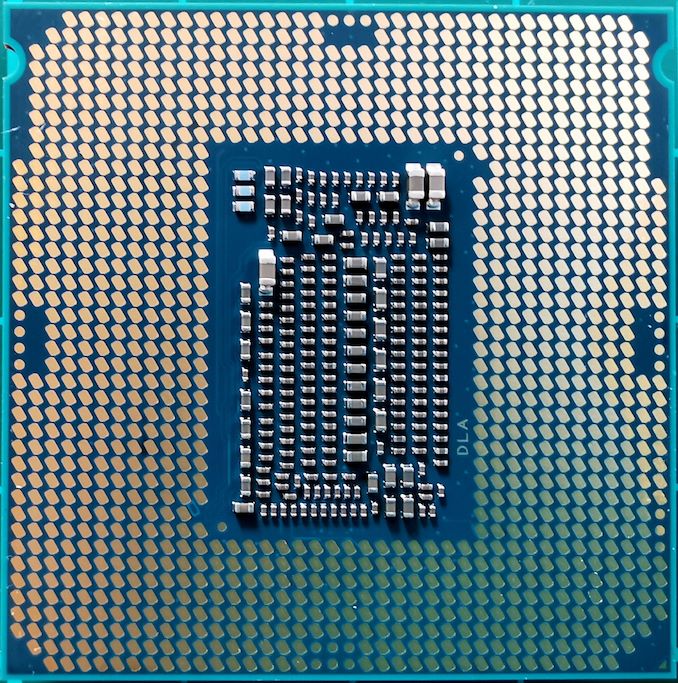
The Core i7-9700K: Intel's Latest Top Core i7 (now with 8 cores)
Our final processor for testing is the Core i7-9700K. This is not the flagship of the current Coffee Lake generation (which is the i9-9900K), but has eight cores without hyperthreading. Going for the 9900K with double the cores and threads is just a little overkill, especially when it still has a tray price of $488. By contrast, the Core i7-9700K is ‘only’ sold in bulk at $374, with a 3.6 GHz base frequency and a 4.9 GHz turbo frequency. The 95W TDP falls foul of Intel’s definition of TDP, and in a consumer motherboard will actually consume ~125W at full load. Memory support is DDR4-2666 as standard.
| Upgrading an Overclocked Intel Core i7-2600K Comparison CPUs |
||||
| Core i7-2600K |
Core i7-2600K at 4.7 GHz |
Core i7-7700K |
Core i7-9700K |
|
| Released | Jan 2011 | Jan 2011 | Jan 2017 | Oct 2018 |
| Price (1ku) | $317 | $317 | $339 | $374 |
| Process | 32nm | 32nm | 14nm | 14++ |
| uArch | Sandy Bridge | Sandy Bridge | Kaby Lake | Coffee Refresh |
| Cores | 4 plus HT | 4 plus HT | 4 plus HT | 8, no HT |
| Base Freq | 3.4 GHz | 4.7 GHz | 4.2 GHz | 3.6 GHz |
| Turbo Freq | 3.8 GHz | - | 4.5 GHz | 4.9 GHz |
| GPU Gen | 6 | 6 | 9 | 9.5 |
| GPU EUs | 12 | 12 | 24 | 24 |
| GPU Freq | 1350 | 1350 | 1150 | 1200 |
| DDR Support | DDR3-1333 | DDR3-2400 | DDR4-2400 | DDR4-2666 |
| PCIe | 2.0 x16 | 2.0 x16 | 3.0 x16 | 3.0 x16 |
| AVX | Yes | Yes | Yes | Yes |
| AVX2 | No | No | Yes | Yes |
| Thermal | Solder | Solder | Grease | Solder |
| TDP | 95 W | N/A | 91 W | 95 W |
The Core i7-2600K is stuck on DDR3 memory, has PCIe 2.0 rather than PCIe 3.0 support, and although not tested here, isn’t built for NVMe storage. It will be interesting to see just how close the overclocked results are to the Core i7-7700K in our tests, and how much of a direct uplift is seen moving to something like the Core i7-9700K.
Pages In This Review
- Tackling the Core i7-2600K in 2019
- Sandy Bridge: Inside the Core Microarchitecture
- Sandy Bridge: Outside the Core
- Test Bed and Setup
- 2018 and 2019 Benchmark Suite: Spectre and Meltdown Hardened
- CPU Performance: System Tests
- CPU Performance: Rendering Tests
- CPU Performance: Office Tests
- CPU Performance: Encoding Tests
- CPU Performance: Web and Legacy Tests
- Gaming: World of Tanks enCore
- Gaming: Final Fantasy XV
- Gaming: Civilization 6
- Gaming: Ashes Classic
- Gaming: Strange Brigade
- Gaming: Grand Theft Auto V
- Gaming: Far Cry 5
- Gaming: Shadow of the Tomb Raider
- Gaming: F1 2018
- Power Consumption
- Analyzing the Results
- Conclusions and Final Words












213 Comments
View All Comments
Midwayman - Monday, May 13, 2019 - link
I think the biggest thing I noticed moving to a 8700k from a 2600k was the same thing I noticed moving from a core 2 duo to a 2600k. Less weird pauses. The 2600k would get weird hitches in games. System processes would pop up and tank the frame rate for an instant, or just an explosion would trigger a physics event that would make it stutter. I see that a lot less with a couple extra cores and some performance overhead.tmanini - Monday, May 13, 2019 - link
I agree, the user experience is definitely improved in those ways. Granted, many of us think our time is a bit more important than it likely really is. (does waiting 3 seconds really ruin my day?)ochadd - Monday, May 13, 2019 - link
Enjoyed the article very much.Magnus101 - Monday, May 13, 2019 - link
You get about 3Xperformance when going from an upclocked 2600k@4.5GHz to a 8700k@4.5GHz when working in DAW:s (Digital Audio Workstation), i.e running dozens and dozens of virtual instruments and plugins when making music.The thing is that it is a combination of applications that:
1. Use all the SSE/AVX or whatever all the streaming extensions that makes parallell flotaing point calculations go much faster. DAW is all about floating point calculations.
2. Are extremely real-time dependent to get ultra low latency (milliseconds in single digits).
This makes even the 7700 k about double in performance in some scenarios when compared to an equally clocked 2600k.
mikato - Monday, May 13, 2019 - link
"and Intel’s final quad-core with HyperThreading chip for desktop, the 7700K""the Core i7-7700K, Intel’s final quad-core with HyperThreading processor"
Did I miss some big news?
mapesdhs - Monday, May 13, 2019 - link
"... the best chips managed 5.0 GHz or 5.1 GHz in a daily system."Worth noting that with the refined 2700K, *all* of them run fine at 5GHz in a daily system, sensible temps, a TRUE and one fan is plenty for cooling. Threaded performance is identical to a stock 6700K, IPC is identical to a stock 2700X (880 and 177 for CB R15 Nt/1t resp.)
Also, various P67/Z68 mbds support NVMe boot via modded BIOS files. The ROG forum has a selection for ASUS, search for "ASUS bolts4breakfast"; he's added support for the M4E and M4EZ, and I think others asked the same for the Pro Gen3, etc. I'm sure there are equivalent BIOS mod threads for GIgabyte, MSI, etc. My 5GHz 2700K on an M4E has a 1TB SM961 and a 1TB 970 EVO Plus (photo/video archive), though the C-drive is still a venerable Vector 256GB which holds up well even today.
Also, RAM support runs fine with 2133 CL9 on the M4E, which is pretty good (16GB GSkill TridentX, two modules).
However, after using this for a great many years, I do find myself wanting better performance for processing images & video, so I'll likely be stepping up to a Ryzen 3000 system, at least 8 cores.
mapesdhs - Monday, May 13, 2019 - link
Forgot to mention, someting else interesting about SB is the low cost of the sibling SB-E. Would be a laugh to see how all those tests pan with with a 3930K stock/oc'd thrown into the mix. It's a pity good X79 boards are hard to find now given how cheap one can get 3930Ks for these days. If stock performance is ok though, there are some cheap Chinese boards which work pretty well, and some of them do support NVMe boot.tezcan - Monday, May 13, 2019 - link
I am still running 3930k, prices for it are still very high ~$500. Not much cheaper then what I paid for it in 2011. I am yet to really test my GTX 680's in SLI. Kind of a waste, but they are driving many displays throughout my house. There was an article where some Australian bloke guy runs an 8 core sandy bridge - e (server chip) vs all modern intel 8 core chips. It actually had the lowest latency so was best for pro gamers, lagged a little behind on everything else- but definitely good enough.dad_at - Tuesday, May 14, 2019 - link
I run 3960X at ~ 4 GHz on X79 ASUS P9X79 and have nvme boot drive with modified BIOS. So it is really interesting to compare 2011/2012 6c/12t to 8700K or 9900K. I guess it's about 7700K stock, so modern 4c/8t is like old 6c/12t. Per core perf is about 20-30% up on average and this includes higher frequency ... So IPC is only about 15% up: not impressive. Of course in some loads like AVX2 heavy apps IPC could be 50% up, but such case is not common.martixy - Monday, May 13, 2019 - link
Oh man... I just upgraded my 2600K to a 9900K and a couple days later this article drops...The timing is impeccable!
If I ever had a shred of buyer's remorse, the article conclusion eradicated it thoroughly. Give me more FPS.
I saw a screenshot of StarCraft 2. On a mission which I, again, coincidentally (this is uncanny) played today. I can now report that the 9900K can FINALLY feed my graphics card in SC2 properly. With the 2600K I'd be around 20-60 FPS depending on load and intensity of the action. With the new processors, it barely ever drops below 60 and usually hovers around 90FPS. Ingame cinematics also finally run above the "cinematic" 30 FPS I saw on my trusty old 2600K.